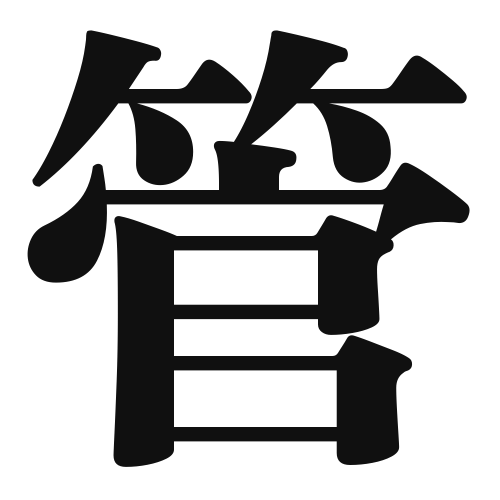1. Overview of Meaning
The kanji “管” (kan) primarily means “pipe” or “tube.” It refers to a hollow cylindrical object used for conveying substances such as liquids or gases. Additionally, it can denote the act of managing or controlling something.
2. Formation and Radical
Formation of the Kanji: The kanji “管” is a phono-semantic compound (形声文字), which means it combines a phonetic component with a semantic component. The left part “竹” (bamboo) suggests a connection to something long and hollow, while the right part “官” (official) relates to management or authority.
Radical: The radical of “管” is “竹” (bamboo), which is often associated with objects that are long and cylindrical.
3. Examples of Usage
Common Words and Phrases: Some frequently used words that include “管” are:
- 管楽器 (かんがっき, kangakki) – wind instruments
- 管制 (かんせい, kansei) – control or regulation
- 管轄 (かんかつ, kankatsu) – jurisdiction
Example Sentences in Daily Conversation:
- この管は水を通すために使います。 (This pipe is used to carry water.)
- 彼はプロジェクトを管轄しています。 (He is in charge of the project.)
4. Synonyms and Antonyms
Similar Kanji: A similar kanji is “筒” (つつ, tsutsu), which also means “tube” but is more specific to cylindrical containers. While “管” can refer to various types of pipes, “筒” typically refers to a more rigid structure.
Antonyms: An antonym for “管” could be “閉” (へい, hei), which means “to close” or “to shut,” representing the opposite action of conveying or allowing flow.
5. Cultural and Historical Background
Relation to Japanese Culture: In Japanese culture, bamboo (the radical of “管”) is highly valued for its strength and versatility. It is often used in traditional crafts, architecture, and even in musical instruments.
Proverbs and Idioms: One common idiom is “管を巻く” (かんをまく, kan o maku), which means to talk excessively or to ramble on, reflecting the idea of a pipe that can carry a lot of sound or information.
